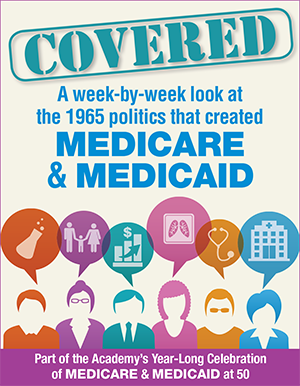Bob Rosenblatt, Special Correspondent
Welcome to Covered: A Week-by-Week Look at the 1965 Politics that Created Medicare and Medicaid. Bob Rosenblatt, a Senior Fellow at the National Academy of Social Insurance, former Los Angeles Times Washington correspondent, and editor of the website HelpWithAging will blog on the maneuvers that led to the enactment of Medicare and Medicaid on July 30th, 1965 the first major expansion of U.S. social insurance to health care.
Millions of Kids to Get Health Care Access Under House Medicare Bill
April 3, 1965
By Bob Rosenblatt – Special Correspondent
With the most observers focused on the question of how to provide seniors with better access to hospital care, few may notice that under the House legislation, some of the biggest winners may be some of that body’s smallest constituents: millions of poor children. They would get access to comprehensive health care under the Medicare bill now being debated by Congress.
Title IX of the bill, which creates a major new federal role in the financing of medical care for the indigent, would help 3.2 million dependent children under the age of 18 that are in families receiving financial aid from the state because of very low incomes. They would now be eligible for the full range of medical benefits promised to people over the age of 65: care in the hospital; coverage of doctors’ bills; and post hospital care in nursing homes or at home. These benefits would become standard care for these poor children, as well as for poor people of all ages who are blind or disabled.
The bill, approved last month by the House Ways and Means Committee, assists children by boosting funding for several programs, including state-run Aid to Families with Dependent Children (AFDC).
Currently, only a relatively small number of people are receiving benefits from state governments. Although there are programs like the Kerr-Mills program to offer medical assistance to poor families, it is up to the state to decide how much assistance to provide and who is eligible. As a result, these programs typically operate under tight budget control.
Under the legislation pending in Congress, the federal government will provide a significant share of the funding for these programs – for most states, around half of the total cost. For the poorest states, the federal government will pick up as much as 80 percent of the tab. One Republican senator called the provisions in Title IX “a sleeper” that could drive up future spending immensely.
As part of the effort to help low-income children, the bill also includes new federal outlays: $5 million for 1967, $10 million for 1968 and $17.5 million each year thereafter. The funds are go for “training professional personnel for health and related care of crippled children, particularly mentally retarded children and children with multiple handicaps,” according to the Way and Means committee report on its bill, which was approved March 29.
The bill also authorizes the Secretary of Health, Education and Welfare to launch a five- year program to provide comprehensive health care and services for children of pre-school and school age. The program would offer states grants to ensure there was screening, diagnosis and treatment for the children, particularly in areas with concentrations of low-income families.
The committee report said new spending is needed to help a large population of children who are either in poor health or at-risk for health problems. According to the report, there are approximately 10.2 million children in need of eye care and 1.5 million children that have hearing impairments; at the same time, one in five children under the age of 17 has a chronic health problem and one in two children under age 15 have never been to a dentist’s office.
One goal of the bill is to make it easier for poor families to get benefits. States today often have complex rules and slow bureaucratic procedures making it difficult for the poor families that appear to be eligible to actually get benefits. “These people are the neediest in the country….they will have the first call upon the resources of the States to provide medical care,” according to the committee report.
One way the bill would do this is to eliminate the financial requirement that counts as income the financial support from absent fathers, whether or not the money is actually paid. That promised but undelivered money often stands as a barrier to families receiving a check under the AFDC program. The same is true for state provisions that require financial support from other members of a family. Such “requirements imposed are often destructive and harmful to the relationships among members of the family group,” the committee report said. Other than a spouse or the parent of a minor child or a grown child who is blind or otherwise permanently disabled, states may not require contributions from relatives as part of their eligibility determination, according to the committee report.
With the federal government setting the standards, the Medicare bill could provide a large group of poor Americans, including children, access to medical care and treatment that is now available only to those who can afford to buy private health insurance.
► Directory of COVERED posts
► Learn more about the Academy’s celebration of the 50th anniversary of the enactment of Medicare and Medicaid

